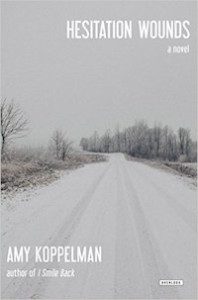
The contemporary, well-educated, well-heeled, professional human being who resides in cities and is sophisticated about food, culture, finance and fashion, is also often a total dolt about her inner life. Unconsciously (and conveniently) she constructs a job and a social life that keep her messy emotions and painful memories at bay. The weak sutures on her wounds must of course give way when the right force collides with her carefully constructed walls.
Amy Koppelman, author of the novel I Smile Back (now a movie with Sarah Silverman and Josh Charles), places such a human at the center of her third book, Hesitation Wounds. Dr. Susanna Seliger is a psychiatrist who sees patients with treatment-resistant depression. Dr. Seliger offers meds and ECT but never a deeply felt interaction. Susa is extremely well defended against the grief, pain and what-ifs of losing her adored, moody graffiti-artist brother when they were both teenagers. Her professional specialty is a buffer against this painful past, a refusal to indulge in emotions or memories that would undo her.
Susa’s life didn’t stop when her brother died, but she has spent the last several decades denying herself love under the assumption that everyone she loves will go away. It’s a downer of a worldview, but she doesn’t let it show, keeping up appearances with intelligence and wit. But her flip tone doesn’t succeed at concealing the deep pain she’s fending off.
Later. In the terminal. I bought a box of Cracker Jack. I mention this because a box of Cracker Jack, in spirit, is essentially what I’ve come to have faith in after all these years. Twenty-eight years. Deep lines flank the sides of my mouth. Every so often I pluck an unruly hair from my chin. Candy-coated popcorn, peanuts, and a prize, Sure, they’ve changed too. Long gone are the days of miniature compasses and plastic rings. The free treasures are paper now. That morning the Cracker Jack elves gave me the code to their pinball app. Yes, it’s easy to roll your eyes.
Pinball? Smartphone? Really?
Stop.
Belittling nostalgia is a frightened man’s parlor trick. Be grateful for any prize. Even a paper fortress, albeit briefly, provides shelter from rain.
And you’re still dead.

Susa has lived for years with a man she doesn’t seem to particularly like and who regularly cheats on her. This melancholy stasis is disrupted by a patient’s suicide that brings the past roaring back into Susa’s present. The patient reminds her of her lost brother and she must confront, not only the circumstances of how her brother died, but the overwhelming evidence that she has been deliberately depriving herself of love and connection for most of her life.
Koppelman’s creative sweet spot is the chronicling of a woman’s mind as she comes apart. Her prose imitates the mental processes of thought and dream, the first person narration pinging from layer to layer, from past to present. There are subtle indications—repeated phrases, a trip to the airport mentioned at the beginning and the end of the book—that all of Hesitation Wounds takes place in an instant. It’s almost as if Susa is recalling the forty-plus years of her life—love lost, regret, unanswered questions, tentative resolution—and they all exist in the single moment it takes for her to complete the thought. Koppelman’s short sentences read like bits of poetry or song lyrics. Her snapshot images build on each other, creating a kaleidoscope of Susa’s life.
Susa’s brother is her adored north star. She addresses him directly throughout the book and tells him at the outset what they both know: “The people who love you leave.” And later, “Love went in only one direction. Away.” Susa can only heal herself by going back in time through her memories, all the way back to the source of her immense pain—the night her brother died tagging a subway car.
Susa and her brother were young in New York City in the late ’70s and early ’80s, and Koppelman wonderfully evokes that time and place. Free-range teens moved about the city, parents were absent in one way or another, taggers were daredevil artists as well as criminals, injustice was a daily headline, and warmly lit apartments offered little solace from the relentlessly grim city in decline. The urban soundtrack was Pat Benatar and Run-DMC. On this journey, captured in the second half of the novel, Koppelman reveals Susa to be a brave woman who is unafraid to search for hope in a broken world and even willing to discover it within herself.
Throughout this slim novel, Koppelman maintains a mood that could, in lesser hands, dissolve into melodrama, but she succeeds with careful observations in precise and potent language. Her story structure is shaped by an arc of memory; the reader rides the wave of Susa’s contemplation. At the conclusion, amid the long-gone loved ones and the yearning memories, the gaping loss, the years, the tears—Susa manages to find a tentative belief that love might stay.




